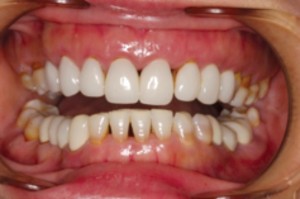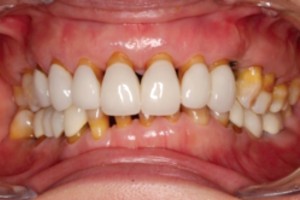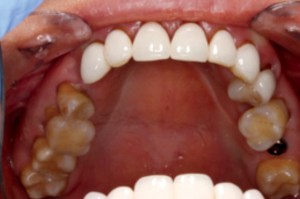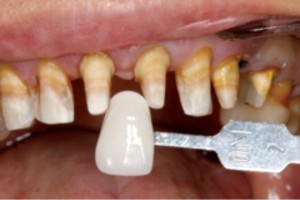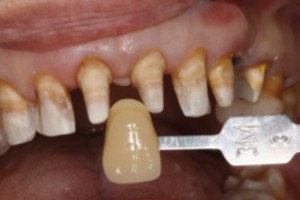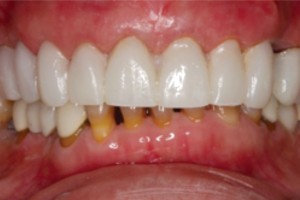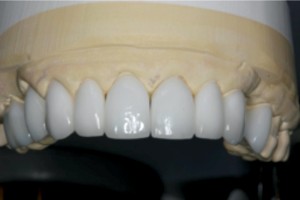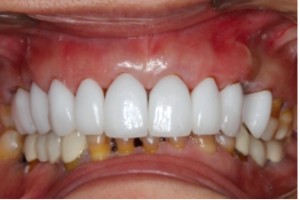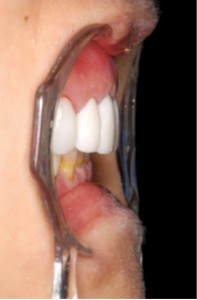Do no harm. We as dentists understand this statement to a T. Our patient’s? Well that’s another story.
Cases do fail. Sometimes they fail because we make errors. Sometimes they fail due to unforeseen circumstances. In any event, a failed case is just that… a failed case. I can certainly speak for myself when I say that I am my toughest critic. I put the blame squarely on my shoulders when I know I could have done things differently in any case that has failed in my opinion. Sometimes I consider a case a failure, even though the patient is ecstatic with the outcome. There is another very important factor though in failed cases. What do we do in the case of patient interference, or patient’s inability to make up their minds, or patient’s inability to be happy? How can we as dentists accept the blame for this? This satirical article explores deep into a case failure that arguably could be considered a patient-driven failure.
Case Study
Meet our patient (Figs. 1 & 2). She came to our office because she did not like her puffy gums and her old crowns/veneers left her wanting more. I explained to her that her periodontal condition was severe enough that she would be losing several teeth, especially 17 and 24. I further explained to her that she would require aggressive scaling root planing and periodontal surgery to allow us to be able to consider replacement of her old restorations. She was completely open to referral to a periodontist to clean up her moderate to advanced periodontitis. Over a 12-month period, she had thorough debridement and pocket elimination surgery. Her oral hygiene improved dramatically as well, enough so that the periodontist was completely on board with our treatment planning for replacement of her old restorations.
I should have considered our next appointment a warning to me. Without including me in her treatment planning, she decided to instruct the periodontist to extract and place implants in the positions of 17, 24, and 47, and this is how she presented herself to me. She said she wanted the veneers done and the implants restored as well.
Here is our patient at that next consultation appointment. At the time of this appointment, she was eager to find out how we were going to fix everything from the poor esthetics, restoring the implants, as well as the ever-present post-perio surgery black triangles (Figs. 3 & 4). The patient also decided ahead of this appointment that she did not want to do restorative on the lower teeth or any teeth other than the ones that already had restorative on them except for 24 which needed an implant crown. She also decided that she could not wait until after the implant on 24 was completely integrated to the bone. The periodontist was completely fine with us leaving the 24 area alone and proceeding with the remainder of the restorative in the meantime.
Treatment Plan
Figure 5 shows the maxillary arch with implants at 17 and 24, and missing 15. Previously, she had full crown preps on 11, 21, and 23. Even though she only wanted old restorations replaced, I convinced her to at least include 16, and 25 in the treatment plan. Missing 15, at least by doing a mesiofacial veneer on 16 and a distofacial veneer on 14, we could attempt to get rid of the black triangle there. For her, black triangles were her biggest complaint. Our treatment plan consisted of facial veneers on 16, 14, 13, 12, and 22. Crowns on 11, 21, and 25, as well as a future implant crowns on 17 and 24. As customary in our office, the next step is to take a set of VPS study models, take a facebow record and bite record, and send this to my lab for a diagnostic waxup. Along with the waxup, a detailed lab prescription was sent ensuring that the lab technician constructing the waxup had all the necessary guidelines for this case. This includes length of the restorations from gingival crest to incisal. All these measurements were obtained during the impression appointment. Also, a complete set of intraoral photos was sent with the case.
The patient sent me at least five different smile design photos from the Internet on separate occasions after the case had already been sent to the lab. Each time the photos were different. Some had square teeth, some rounded, and some tapered. I finally told her she had to pick a style that she wanted and not to change her mind again.
Once the waxup was returned to us, the patient had the final confirmation/consultation appointment. At this time, the models were reviewed with the patient and her husband to insure that we were all on the same page with regards to the eventual restorations. The patient decided she yet again wanted to make minor changes to the waxup. She then demanded that the waxup be returned to the lab to make the necessary changes and return them to us for her to check. The patient and husband returned again and verified the changed waxup, which they approved. At this time, the patient and her husband were told that once we prepare the teeth and the impressions were sent to the lab, they would follow the waxup exactly and no changes would be permitted once the fabrication process had started. All were in agreement, and this was documented in her chart.
Preparation Appointment
At this appointment, the patient confirmed that the shade she wanted was 0M2 for her restorations. We then started to remove all existing old restorations and discovered that the old preparations were way over prepped and in some cases the porcelain was 3 mm thick. This was not too much of a problem as we had lots of room to fabricate the new restorations and make them thinner and more lifelike. All teeth were re-prepped and working shade (Fig. 6) and stump shade (Fig. 7) photos were taken.
It was once again made very clear to the patient that once the case was sent to the lab, there could be no changes made. She quickly decided that instead of shortening her 11 and 21 slightly as I thought would be best, she wanted them the same length as previous. She thought about the shade and confirmed that 0M2 was her shade. She thought 0M1 would be too white for her. We fabricated her provisionals using the shrink wrapped technique and took a final photo (Fig. 8).
The patient loved the provisionals and said, “I want the permanent ones like this!” We documented the length change in her chart and again told her that no further changes could be made once the case was sent to the lab.
The Beginning of the End
To this point, I had the belief that the patient and our team were on the same page with the same end goals in sight. Unfortunately it became apparent that this was far from the truth. Five days after the case was sent to the lab, the patient phoned our office to speak to me and told me that she changed her mind after speaking to her husband and she wanted the shade changed to 0M1, the whitest shade possible. I explained to her that once the case is in lab, there were no more changes possible. Her response was that this is what she wants though and she is paying me to deliver what she wants. That statement, while crass, is in itself true. Without promising her that it would possible, I phoned the lab technician and luckily they were just about to start layering the porcelain on the case. They changed the working shade to 0M1 and all was well with our patient. Except now, this is where the case started to unravel.
Try-in Appointment
The case arrived back from the lab, the shade verified, and the restorations were checked against the diagnostic waxup for shape and contours as well as the length. Figure 9 shows the beautiful restorations as tried on the working model.
We see the beautiful work, and exactly as per our specifications following the confirmed diagnostic waxup. Figure 10 shows the restorations tried onto the patients teeth.
In my opinion, everything was done exactly as per the patient’s wishes. My opinion, which I shared with her, was that the overall lengths of the teeth were too long but this is what she wanted. She understood that any black triangles or darkness at the gingiva showing would be gone within a few days when the tissue relaxed after they were compressed by the provisionals. The only thing that the patient did not like was the shade. She said that they were too white! Both my assistant and I were shocked since the patient was the one who demanded we change the shade to 0M1 in the first place. She demanded that the veneers go back to the lab and that they remake the restorations to 0M2. I explained to her as I had done over and over at the beginning that once the lab has delivered what we have asked them to do, any change fees incurred at that point are her responsibility. Her response: “But I am not happy!” Those words resonated with me. In my mind the one thing that any of my patients need to be at the end of the day is happy. I called the lab, and they agreed to change the shade. I also made it clear to the patient that if there is anything that she would like to see changed we should do it now. She said that everything else is perfect. So back to the lab they went. It was here that all control was lost by me. Once the patient was allowed to change her mind, and without penalty, she took control of the case and would continue to demand changes.
Insertion Appointment
Fortunately, when the case returned for the tryin/insertion appointment, I had requested that the patient come to the appointment with her husband. I felt that if she had him there with her he could help her decide whether the restorations were acceptable. We tried them in again. Again, to our team, they looked exactly like she had requested. We verified the shade in all lighting conditions. Her husband thought that they were great. Once again, I stressed that once inserted permanently into her mouth, only very minor changes could be made intraorally so she had to be sure that they looked perfect. Her response made my blood boil. She looked at my assistant and said, “What do you think Kim? Too dark? Too light? I think they are too dark!” We had just sent them back because she thought that they were too white and wanted them darker. The lab muted the colour down to 0M1.5, not even 0M2. Her husband said they look great and she consented to having them inserted. Figure 11 shows the veneers at the follow-up appointment, which is usually one week after insertion.
Follow-up Appointment
By now, the utter relief of finishing the case the last appointment had taken over and we eagerly awaited her return to finalize this portion of her treatment, and to continue on with the remainder of the case. Upon arrival, her and her husband had returned together. Her reaction was not as expected. She started out by saying that the veneers were too long (remember I had advised her to shorten them but she wanted the length of the provisionals). We could shorten them slightly. Then she continued to pick apart every veneer and said, “Let’s replace them”. Replace them? That was not happening. What proceeded to happen over the next appointments was that she demanded that we shorten, change labial contours of the centrals (because she thought that there was a horizontal ridge in the center of the teeth). Figure 12 shows the side profile prior to adjustment.
Now that all we were doing was contouring and re-polishing each appointment, the original esthetics of a successful case were lost by the constant desire of the patient to change what she had requested. Each subsequent appointment started by asking what my assistant thought, and then telling us to adjust this or that and ending her comments the same way. ”I’ll never be happy, because I am never happy!” There is the truth for sure. She will never be happy. The patient requested that we finish the implants on 17 and 24. We took final impressions to fabricate the final restorations and the patient left on holidays for a month. Three months later, she returned to our office for insertion of the final crowns and funny enough; she had the implants restored in her home country. That was the last I saw of her.
Lessons to Learn From This Case
Every case teaches us something. This case was certainly no exception. This case reaffirmed what I already knew. Make sure that everything is in writing and signed by the patient. That is the only thing that will potentially prevent litigation with an impossible patient. However we did learn more as well.
Make sure the patient understands every aspect of the case.
Ensure that once a treatment plan is accepted, there are to be no changes unless the patient understands that this may affect the outcome of the case and may require redoing the case at full charge.
Be very aware of the signs of a patient trying to take control of the dentistry that we do.
We do not need to treat every patient in our office. Recognize that there will be times that certain personalities will not allow you to do your best work.
Fortunately, this scenario does not happen very often. Sometimes patients do not listen, and need to be constantly reminded about issues surrounding a case. This is the beginning of the end. Cases can fail because of patient interference, but ultimately a failed case is a failure.
Acknowledgements
I would like to thank the superb work, care, patience and understanding of Valley Dental Arts in Stillwater, Minnesota for their tireless efforts. OH
Dr. Rykiss maintains his private practice in Winnipeg, MB. He is a graduate of the University of Manitoba as well as a graduate and Mentor at the Nash Institute for Dental Learning in Charlotte, N.C. He has his Fellowship with the International Academy for Dental Facial Esthetics, an associate Fellowship from the World Clinical Laser Institute, and is a member of the ASDA and CAED. He teaches, lectures, and writes articles on restorative, cosmetic dentistry, and hard and soft tissue laser use.
Oral Health welcomes this original article.
RELATED ARTICLE: Biomechanical Implant Failures Management of an Implant Failure: A Case Report


